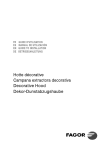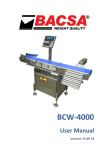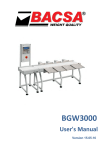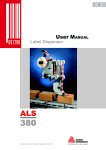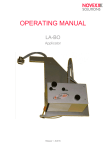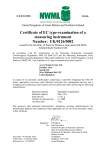Download user`s manual for the header bag machine, version 46-2-05
Transcript
User’s Manual 46-2-05 Please notify any errors to : [email protected] 6- USER’S MANUAL FOR THE HEADER BAG MACHINE, VERSION 46-2-05 This document comprises the following sections: SECTIONS WHICH THE USER MUST READ 6.1 - Programming the parameters which are necessary for commencing work with the machine. 6.2 - Operation processes. SECTIONS WHICH MUST BE READ BY MAINTENANCE PERSONNEL 6.3 - TEST processes. 6.4 - Temperature adjustment process. 6.5 - Hidden pages. 6.6 - Codeword summary. 6.7 - Alarm list. SECTIONS WHICH ARE COMPULSORY TO BE READ BY QUALIFIED PERSONNEL ONLY 6.8 - Programming the times and parameters required for machine operation. 6.9 – Operating drawings. 46-2-05 : 1 6.1 – PROGRAMMING THE NECESSARY PARAMETERS FOR COMMENCING MACHINE OPERATION. The following screen is displayed when the machine is connected to an electricity supply: A menu is displayed with all the main options. 6.1.1 – TEMPERATURE PARAMETER PROGRAMMING Pressing this key will display the following screen: The cursor keys (Å) (À) are used to move over the page in order to select the field to be modified. The selected field is displayed in white on a black background. Once the required field has been selected, the required value may be entered, and 46-2-05 : 2 then the “M” key is pressed to validate the value. The ESC key should be pressed after entering all the data, which will save it in the non-volatile memory (EEPROM). The following screen is displayed while the data is being saved: 6.1.1.1 – PARAMETER DESCRIPTION. This value is used to programme the cycle percentage1 during which the cutting blade heater is switched on. This value is used to programme the time interval between temperature conversions. The values for the operating temperatures in the various zones are programmed. The ZONE 3 value is that of the cutting blade resistance; since this zone does not have any proportional control this value is only used to provide an alarm and will not permit any machine operation until the temperature is correct. This is important because the mesh will not be cut if the temperature is not the correct one and this could lead to problems. 1 This value is the percentage of full output current every 20 msec. 46-2-05 : 3 46-2-05 : 4 When this is the temperature span lacking to reach the set point temperature, the zone heater connection then becomes proportional, the greater the temperature span lacking to reach the set point value, the longer the heater is switched on. When less temperature is required to reach the set temperature, then the heater is switched on for less time. The proportional switch on / switch off time for the heater is divided into the previously programmed temperature reading interval. If the temperature reaches a value within the margins (set point zone – deviation alarm margin) and (set point zone + deviation alarm margin), the temperature “outof-range” alarm remains inoperative. This value is used to programme the cycle percentage2 during which the film heater element is switched on. The film heater option is selectable from the main screen as explained previously in this document. NOTE: When the machine is first switched on, the heating process is initiated in a progressive manner during several minutes to protect the heating resistors. 2 This value is the percentage of full output current every 20 msec. 46-2-05 : 5 6.1.2 – TIME PROGRAMMING. Pressing this key will display the following screen: The cursor keys (Å) (À) are used to move over the page in order to select the field to be modified. The selected field is displayed in white on a black background. Once the required field has been selected, the required value may be entered, and then the “M” key is pressed to validate the value. The ESC key should be pressed after entering all the data, which will save it in the non-volatile (EEPROM) memory. The following screen is displayed while the data is being saved: 46-2-05 : 6 6.1.2.1 – TIME DESCRIPTION. This time begins to elapse when the gate opens to load the product inside the bag; once this delay has elapsed, the gate is closed. Once the FILM welding has been completed, FILM COOLING is switched on when the clamps are opened and this time begins to pass. When it elapses, FILM COOLING is switched off. The required length of FILM is programmed. Since this value is approximate, it is necessary to readjust it until the required size is achieved. If the machine is operating in MARK mode, then the value should be slightly larger than the size defined by the MARK. If, for any reason, the MARK is not recognised, the FILM will stop on reaching the programmed length. If the machine is operating in NO GATE mode, then this timer starts when during rotation the sensor detects the “up” torpedo. At the end of this time, the machine requests a packet from the weighing machine. This is the time during which the FILM is being welded in Phase 2. If stretching has been selected, this timer starts on stretching beginning, its setting enabling selection of the desired amount of stretch. After time count ending, bag processing continues. 46-2-05 : 7 6.1.3 – FILM HEATING SELECTION. Pressing key (F9) permits selection / cancellation of the FILM heating option (this is only required for certain FILM types) When the heater is selected, the following indication is displayed 6.1.4 – MESH LOADING PROCESS. Pressing key (F8) prepares the machine for an easy mesh loading. This icon is displayed while it is in this position: If key (F8) is pressed again, the machine changes over to standby position. This process may also be carried out using the MESH LOAD pushbutton. 6.1.5 – SELECTING WORKING WITH / WITHOUT GATE. Key (F7) is used to select whether to work with the gate or not. The machine is normally operated with the gate (a packet is requested from the weighing machine just as soon as the gate has been emptied and the command to close it has been given). The “no-gate” mode is used when products form bridges on the gate (in this mode the packet request is made a certain time [T-19] after commencing plate rotation.) The following symbol is displayed if the gate is selected: The following symbol is displayed if the gate is not selected: If the gate and ram for in-line onions are selected the following symbol is displayed: If the gate and ram for in-line onions are not selected the following symbol is displayed: 46-2-05 : 8 6.1.6 – DELETING PHASE MEMORIES. Pressing (F6) displays the following screen: Confirmation of whether to delete these memories or not can now be given. This could be necessary for the following reason: While the machine is operating, it saves memories each time it finishes a phase so that if the process is halted and then restarted, any phases which have been commenced are considered finished and are not carried out. If, for any reason the mesh for one or more phases is removed while the machine is halted, then when operation is restarted, any phases in memory will not be carried out even though they have not been actually carried out. Therefore, if the mesh is removed from one of the phases, it is recommended to remove the mesh for the remaining phases and delete their memories. 6.1.7 – SELECTING FILM DOSING MODE. Pressing key (F5) enables one of two modes to be selected, by TIME or by MARK. If the TIME mode is selected, the FILM will emerge during the time required to reach the defined FILM length (see section 6.1.2.1 of this document.) In fact, when a FILM length is defined, the machine calculates the time during which the FILM dosing motor should be switched on. If the MARK mode is selected, this means that the FILM being used displays black marks at regular intervals so that when the associated sensor detects one of these marks the FILM dosing motor will stop. The following symbol is displayed when TIME mode is selected: 46-2-05 : 9 The following symbol is displayed when MARK mode is selected: 6.1.8 – MAKING A LABEL. If the transfer labeller is selected (from the configuration menu, [9][9][9][C] from the test menu) and it is also selected by means of key [F2](see section 6.1.9), then when key [F4] is pressed a label is produced. The following symbol is displayed while the label is being produced: 6.1.9 – SELECTING THE LABELLER. If the transfer labeller is configured, key [F2] may be used to select whether the labeller is to be employed or not. The following symbol is displayed when it is selected: The following symbol is displayed when it is not selected: 6.1.10 – SELECTING VIBRATION. Key [F3] is used to select phase 3 platform vibration while it is being lowered which will assist the introduction of the product into the bag. If vibration is selected, the following symbol will be displayed on the lower right of the screen: 6.1.11 – SELECTING THE WORK MODE. Pressing this key will select or deselect automatic operation. If automatic mode is selected, this symbol is displayed on the screen And indicates automatic communication with the weighing machine. If the automatic symbol is not displayed, the weighing machine requests will be manual by pressing key: 46-2-05 : 10 6.1.12 – SWITCHING TEMPERATURE CONTROL ON / OFF. Pressing key (F1) will switch the temperature control on or off. If heating is selected, the following symbol will be displayed on the lower part of the screen: When heating control is initiated, the actual temperature readings are displayed onscreen under the set point temperatures. While the temperature is below that of the set point less the A deviation alarm margin @ the following is displayed: This indicates that the zones are out of range. The following screen is displayed when the zones reach the programmed temperature: This indicates that the operating process may be started. 46-2-05 : 11 6.2 – OPERATING PROCESS. Pressing START-UP from the main page will initiate the OPERATING process. The following screen will be displayed: This indicates that the heating is not switched on. (ESC) should be pressed to return to the main page and then the (F1) key to switch the heating on. This indicates that the zone temperatures are out of the selected ranges. (ESC) should be pressed to return to the main page; it is then necessary to wait until the insufficient temperature symbol disappears on this same page. If none of these problems exist, the following screen will be displayed: This screen displays the selected temperature set points and options on the main page. 46-2-05 : 11 6.2.1 – AVAILABLE OPERATIONS. Pressing this key will display the times for each of the phases, together with the number of packets / minute (P/M) Pressing this key enables the automatic or manual weighing signal to be selected. Pressing this key when in manual mode will request a packet from the weighing machine. Pressing this key will cause the machine to end the phases being carried out at this time, and then operation will halt before rotation with the machine remaining in standby. The following symbol and screen are displayed: Pressing the (F1), (F2), (F3), (F4) or (F5) keys will enable the machine's phases to be repeated in order to adjust its mechanisms. (F1) = Phase 1, mesh preparation process. (F2) = Phase 2 , FILM welding process. (F3) = Phase 3, packet loading process. (F4) = Phase 4, packet stapling process (F5) = Station rotation. If the (F8) key or the (LOAD MESH) push-button is pressed, the machine is prepared for easy mesh loading. 46-2-05 : 12 The symbol is displayed in this position: Pressing the (F8) key again leaves the machine in the standby position. If the door is opened in this mode, the (DOOR OPEN) indication is displayed, but the temperature control continues to operate and operation can then continue when the door is closed. Pressing this key again will cause the machine to continue operation and the symbol will disappear. 6.2.2 – UNLOADING THE MACHINE. Pressing this key, the machine will finish all the bags in the various phases and then the machine will stop. This enables all the material to be used up leaving the machine ready for another session. The symbol is displayed during the unloading operation: 46-2-05 : 13 6.2.3 – PROGRAMMING THE OPERATING PARAMETERS. While the machine is operating, it is possible to modify certain parameters that may depend on the bag material or product. Pressing the key, the following screen will be displayed: Once the required values have been modified, pressing the (ESC) key will exit the operations page. This allows the temperature set points to be modified in all three zones. This enables the Phase 2 FILM welding time to be modified . This permits the Phase 2 FILM cooling time to be programmed. This allows to adjust the time during which the gate is open in Phase 3 for product dropping. 46-2-05 : 14 6.3 – TEST PROCESSES. When the key sequence (C)(3)(8)(7) is pressed, the TEST page is entered and the following screen is displayed: The associated function key is used to select the required test. Pressing the (ESC) key will display the main screen again. 6.3.1 – OUTPUT TEST. Pressing the (F1) key from the TEST page the following screen will be displayed: The (Å) (À) keys are used to select the output to be tested, and once it has been selected, the (M) key is used to activate / deactivate the output. The output test may be exited by pressing the (ESC) key. 46-2-05 : 15 The (Å) (À) keys are used to change the output page. In this test, pressing the (F1) key will switch on heating regulation if the cutting process is to be actuated upon. If heating is selected, the symbol will be displayed at the upper right of the screen. 46-2-05 : 16 6.3.2 – INPUT TEST. Pressing key (F2) on the TEST page will display the following screen: The input test may be exited by pressing the (ESC) key. The (Å) (À) keys are used to change the input page. 46-2-05 : 17 6.3.3 - ALL INPUTS TEST. Pressing the (F3) key from the TEST page will display the following screen: This enables to check if on activating any input, another one acts simultaneously. Pressing the (ESC) key will exit all inputs test. 46-2-05 : 18 6.3.4 - RAM TEST. Pressing the (F4) key from the TEST page will display the following screen: This initiates the equipment’s RAM memory test. Pressing the (ESC) key will exit the RAM test. 6.3.5 – KEYBOARD TEST . Pressing the (F5) key from the TEST page will display the following screen: Each time a key is pressed, the code corresponding to that key will be displayed at KEY PRESSED, in accordance with the diagram displayed on the screen. (À) = A (Å) = E (Ã) = B (Ä) = D (ESC) = S ........ etc. 46-2-05 : 19 If the (ESC) is pressed, the following screen will be displayed: This indicates that if (ESC) is pressed again the test will be exited, but will continue if any other key is pressed. 6.3.6 – SCREEN TEST. Pressing the (F6) key from the TEST page will display the following screen: It should be verified that the entire screen is filled with characters. Pressing the (ESC) key will exit the screen test. 46-2-05 : 20 6.3.7 – CHANGING THE LANGUAGE. Pressing the (F7) key from the TEST page will display the following screen: This enables the selection of one of the following languages: Spanish, English, Japanese or French. 6.3.8 - MANUAL PHASE OPERATION. Pressing the (F8) key from the TEST page will display the following screen: Pressing the (F1), (F2), (F3), (F4) or (F5) keys will repeatedly perform the machine’s operating phases for adjusting its mechanisms. (F1) = Phase 1, mesh preparation process. (F2) = Phase 2, FILM welding process. (F3) = Phase 3, packet loading process. (F4) = Phase 4, packet stapling process. (F5) = Station rotation. NOTE These operations may be performed as many times as required, however it is not recorded that the phase has been carried out, which means that all phases should be left without mesh when operation is restarted to achieve the process' initiation without any problem. 46-2-05 : 21 For machine adjustment, pressing key will display the times required for each phase. The following screen is displayed: 6.3.8.1 - SELECTING THE WEIGHING MACHINE SIGNAL. Pressing the key enables the automatic packet request to the weighing machine to be selected /deselected. The following symbol is displayed in automatic mode: If automatic mode is not selected, one packet may be requested from the weighing machine by pressing the key 6.3.8.2 – MESH LOADING PROCESS. If the (F8) key is pressed, the machine is prepared for easy mesh loading. The following symbol is displayed in this position: Pressing (F8) key again will leave the machine in standby position. This process can also be carried out using the ( LOAD MESH ) push-button. 46-2-05 : 22 6.4 – TEMPERATURE ADJUSTMENT PROCESS WARNING: THIS OPERATION SHOULD ONLY BE PERFORMED BY SPECIALISED PERSONNEL. IF YOU ENTER THIS PAGE, BUT DO NOT WISH TO CARRY OUT THE ADJUSTMENT OR DO NOT HAVE ALL REQUIREMENTS AVAILABLE, THEN IT SHOULD BE ABANDONED BY PRESSING (STOP), DO NOT LEAVE BY PRESSING (ESC) If the key sequence (6)(9)(6)(C) is pressed from the TEST page, the following screen is displayed: This permits movement with the cursor keys to the data item to be modified, with the actual value being entered using the numeric keys. The process to be followed is given below: The room temperature should be measured with a thermometer and then this value should be entered into the corresponding field. A battery with a voltage divider, providing a voltage of 21.8 mV which is the value produced by a “J” type thermocouple at a temperature of 400°C (21.846 mV), should be connected to the thermocouples installed in the three zones. A value of 400°C should be entered for the three zones. Only when these requirements have been fulfilled the (ESC) key should be pressed. 46-2-05 : 23 The data will be saved in the EEPROM memory and the following screen will be displayed: If the (0) key is pressed, then the page will be exited without changing the settings present at this moment . If the (1) key is pressed, then the adjustment process is carried out. The following screen will be displayed once the adjustment has been completed: It contains the adjustment parameters. Pressing the (ESC) key will exit the temperature adjustment page. It should be remembered that once the (1) key has been pressed, it is not possible to halt the adjustment process, if the data entered or the thermocouple reference value are not correct, the machine will not be properly adjusted and the temperature readings will not be correct. 46-2-05 : 24 6.5 – HIDDEN PAGES. 6.5.1 – DISPLAYING THE NUMBER OF PACKETS PRODUCED. Pressing the (5)(5)(5)(C) key sequence from the TEST page will display the following screen: This indicates the total number of packets produced by the machine. If this value has to be programmed (because of the need to change the card and wishing to maintain the number of packets produced in the new card), by pressing key (5) this figure may be modified. If any other key is pressed, then the page will be exited without modifying this figure. 6.5.2 – SELECTING THE TEMPERATURE ALARM. Pressing the (9)(9)(9)(C) key sequence from the TEST page will display the following screen: This is where the selection of whether to display out-of-range temperatures is made. By default it is always YES. NO is only justified when performing tests on the machine for which the temperature is not important. 46-2-05 : 25 Pressing (ESC) will exit this page and display the following screen: The monitoring of whether the gate is closed may be selected. By default it is always YES. NO is only justified when performing tests on the machine . Pressing (ESC) will exit this page and display the following screen: This will allow the cutting mode to be selected using the (F1) key. Indicates that the cut is always on the opposite side (no return) Indicates that the cut always returns to the original position. Indicates that the cut always returns, however not to the original position, but to an intermediate one instead (this requires a sensor to be placed in the intermediate cylinder zone). 46-2-05 : 26 NOTE Warning: the cutting mode is defined in function of the machine's gearing, which means that it can only operate in one single mode, in the other modes serious problems could arise. Pressing (ESC) will exit this page and display the following screen: Pressing [0], DOES NOT select the labeller (by default) Pressing [1], DOES select the labeller. If the labeller is mechanically installed, then YES must be programmed, as otherwise, it will not be possible to work with it, nor will the labeller selection symbol appear on the screen. However, it is possible to select / deselect labeller operation from the main screen depending on the make-up operations. Pressing (ESC) will exit this page and display the following screen: Pressing [0], selects “closed by STAPLING” (by default) 46-2-05 : 27 Pressing [1], selects “closed by KWIK LOK”. (Depending on machine type, PHASE 4 gearing is different, which means it has to be programmed depending on same). If KWIK LOK is selected, when (ESC) is pressed the following screen is displayed: This permits a selection between a commercial KWIK LOK or that of DAUMAR (KL D). If the KWIK LOK mode is selected, the following symbol will displayed on the main page: If the KL DAUMAR mode is selected, the following symbol will displayed on the main page: 46-2-05 : 28 If STAPLE has been selected, the following screen will be displayed when (ESC) is pressed: This permits the selection of bag “stretch” during the stapling process. The following symbol is displayed when “stretch” is selected: NOTE.- In order to use this option, special gear is required in the stapling phase. 46-2-05 : 29 6.6 – CODEWORD SUMMERY There is a series of hidden pages, which cannot be accessed without a codeword. The existing codewords are as follows: Page Codeword Description Main page (C)(3)(8)(7) Access the TEST page Test page (6)(9)(6)(C) Temperature adjustment process Test page (5)(5)(5)(C) Total number of packets display Main page (C)(4)(6)(0) Machine times programming. Test page (9)(9)(9)(C) Machine configuration. 46-2-05 : 30 6.7 - LIST OF ALARMS Each time an alarms appears, the screen will flash, and a display will be presented as in the following screen: When an alarm appears, the machine will complete the remaining phases and will then suspend operation before turning. Once the problem has been solved, pressing START will continue machine operation. If the alarm corresponds to one of the consumable items, (mesh, strip, film), on pressing START the corresponding phase will be repeated and operation will continue. 6.7.1 – ALARM DESCRIPTION. [1] LOWER CLIP 1 NOT OPEN Alarm number 1 Location PHASE 1 Indicates that the lower clip opening electro-valve has not operated or the limit switch has not detected the bag. [2] UPPER CLIP 1 NOT OPEN Alarm number 2 Location PHASE 1 Indicates that the upper clip opening electro-valve has not operated or the limit switch has not detected the bag. 46-2-05 : 31 [3] TORPEDO NOT RISING Alarm number 3 Location PHASE 1 Indicates that the torpedo “up” electro-valve has not operated or that the torpedo “down” electro-valve is connected, the torpedo has not been detected in this "up" position or an obstacle blocked its path. [4] UPPER CLIP 1 NOT CLOSED Alarm number 4 Location PHASE 1 Indicates that the upper clip closing electro-valve did not operate or that the limit switch has not detected the bag. [5] TORPEDO NOT LOWERING Alarm number 5 Location PHASE 1 Indicates that the torpedo “down” electro-valve has not operated or the torpedo "up" electro-valve is connected or the limit switch did not detect the bag. [6] LOWER CLIP 1 NOT CLOSED Alarm number 6 Location PHASE 1 Indicates that the lower clip “closing” electro-valve did not operate or that the limit switch did not detect the bag. [7] SENSOR CIRCUIT CUT Alarm number 7 Location TEMPERATURE CONTROL Indicates that the zone remains permanently connected and that no temperature changes are displayed. Check that the sensor's or resistor's circuit are not cut. [8] INSUFFICIENT TEMPERATURE Alarm number 8 46-2-05 : 32 Location TEMPERATURE CONTROL Indicates that one or more zones are below the set temperature . [10] NO MESH Alarm number 10 Location PHASE 1 Indicates that there is no mesh or that the mesh is not being detected. [11] CLAMP NOT OPEN Alarm number 11 Location PHASE 2 Indicates that the clamp opening electro-valve did not operate or that the limit switch did not detect the bag. [12] CLAMP IS NOT CLOSED Alarm number 12 Location PHASE 2 Indicates that the clamp closing electro-valve did not operate or that the limit switch did not detect the bag. [13] NO FILM Alarm number 13 Location PHASE 2 Indicates that there is no FILM or that the FILM END is not being detected. [15] LIFT NOT RISING Alarm number 15 Location PHASE 3 Indicates that the lift “up” electro-valve has not operated or that the lift has not been detected. [16] CLOSING DEVICE DID NOT MOVE BACK Alarm number 16 Location PHASE 4 46-2-05 : 33 Indicates that the closing electro-valve did not operate or that the bag is not being detected. [17] CLOSING DEVICE DID NOT ADVANCE Alarm number 17 Location PHASE 4 Indicates that the closing electro-valve did not operate or that the bag is not being detected. [18] STAPLE NOT ADVANCING Alarm number 18 Location PHASE 4 Indicates that the stapling electro-valve did not operate or that the bag is not being detected. [19] STAPLE NOT RETURNING Alarm number 19 Location PHASE 4 Indicates that the stapling electro-valve did not operate or that the detector continues detecting the stapling device in its advanced position. [20] UPPER CLIP 2 IS NOT OPEN Alarm number 20 Location PHASE 4 Indicates that the clip opening electro-valve did not operate or that the sensor did not detect the clip. [21] UPPER CLIP 2 NOT CLOSED Alarm number 21 Location PHASE 4 Indicates that the clip closing electro-valve did not operate or that the detector continues to state that the clip is still open. [22] MOTOR NOT TURNING Alarm number 22 46-2-05 : 34 Location ROTATION Indicates that the rotation motor contactor did not receive any output or that the braking or stopping sensors continue being energised. [26] NO CUTTING OPERATION Alarm number 26 Location PHASE 1 Indicates that the cutting electro-valve did not operate or the detector did not spot he bag. [27] NO STRIP Alarm number 27 Location PHASE 4 Indicates that there is no strip or that the strip sensor did not detect its presence. [28] PLATE NOT IN POSITION Alarm number 28 Location ROTATION Indicates that when rotation has stopped, the plate did not stop in the correct position. [29] BAG NOT RELEASED IN PHASE 4 Alarm number 29 Location PHASE 4 Indicates that after operation of the clip to release the bag, this continues hanging. It must be removed to continue. [30] NO COMPRESSED AIR Alarm number 30 Location GENERAL Indicates that there is no compressed air supply or that it has been cut-off. [9] FILM SEPARATOR NOT MOVED BACK Alarm number 9 46-2-05 : 35 Location PHASE 2 Check whether the film separator has moved back before closing the clamps. [14] PHASE 3 GATE IS NOT CLOSED Alarm number 14 Location PHASE 3 Check whether the phase 3 gate is closed before rotation. The machine is unable to rotate if the gate is open. [23] PHASE 3 GATE IS NOT OPEN Alarm number 23 Location PHASE 3 Check whether the gate is open (if gate operation has been selected). [24] LABELLER NOT RESPONDING Alarm number 24 Location PHASE 4 Indicates that the print command has been issued, but the labeller did not indicate that it did finish. [25] KWIK LOK NOT RESPONDING Alarm number 25 Location PHASE 4 Indicates that the stapling command has been issued to the KWIK LOK machine, but this did not respond. [31] NO KWIK LOK Alarm number 31 Location PHASE 4 Indicates that all KWIK LOK staples had been spent. [32] F1 or F2 MESH ERROR Alarm number 32 Location PHASE 2 46-2-05 : 36 If, during 10 consecutive cycles, the phase 2 mesh sensor does not detect the mesh, then this alarm is displayed. [33] GATE RAM IS NOT IN THE “UP” POSITION Alarm number 33 Location PHASE 3 Before rotation, it checks that the gate ram is in the up position, this alarm being displayed if it is not. [34] GATE RAM IS NOT IN THE “DOWN” POSITION Alarm number 34 Location PHASE 3 This alarm is displayed if the command to lower the ram is issued, but it did not descend enough. [35] STRETCH CLIP IS NOT CLOSED Alarm number 35 Location PHASE 4 This alarm is displayed if the clip closing command is issued during the stretching process, but the sensor does not detect its closure (only if the stretching process is selected). [36] NO STRETCH OPERATION Alarm number 36 Location PHASE 4 The stretch command has been issued, but the sensor does not indicate that the stretching clip has reached the stop (only if the stretch process has been selected) 46-2-05 : 37 6.8 – PROGRAMMING THE TIMES FOR MACHINE OPERATION. ONLY FOR AUTHORISED PERSONNEL ! INCORRECT PROGRAMMING OF THESE PARAMETERS COULD LEAD TO INCORRECT MACHINE OPERATION. Pressing the following key sequence, (C)(4)(6)(0) the following screen will be displayed from the main page: The ( À )( Å ) cursor keys are used to move over the page in order to select the field to be modified. The selected field is displayed in white letters on a black background. Once the necessary field has been selected, the required value is entered and then (M) is pressed to validate the data. The ( Ã )( Ä )keys are used to change the page for the times to be modified. 6.8.1 – TIME DESCRIPTION. When the torpedo is up, the command to switch off the phase 1 upper clips is issued, and this is when the timer commences counting. At the end of this time, the torpedo “down” command is issued. In order to gain time, instead of waiting for the clips to close, the command may be issued earlier, thus gaining the torpedo switch off response time. 46-2-05 : 38 When the motor rotation command is issued on spotting the stopping sensor we take the rotation for having finished, thus enabling the machine to initiate the phases. It is now that the timer commences to count; when it terminates, the motor halt command is issued. (The indexing gear includes a zone in which no output movement is generated even though the motor is rotating. This time enables a close approach to the zone which does really generate movement). During the rotation process, when the torpedo “up” sensor is energised, the timer commences to count. At the end of this time, the torpedo up command is issued. (It is raised during the rotation in order to save time). In phase 4, when the packet has been stapled, upper clip 2 is switched on to remove the packet. When the sensor detects the clips arrival to the end of its travel, this timer commences to count. At the end of the set time, the clip switch-off command is issued. When the cooling timer set value is equal to or less than this figure, phase 2 is considered to be finished, and permits rotation if the other phases have also been finished. When the motor rotation command is issued, this timer commences to count. When count finishes, the FILM dosing process start-up command is issued. When the motor begins to rotate, the command to start this timer is issued. At the end of this time, the command to open lower clips 1 is issued. When during the rotation process the speed changer braking signal is detected, the command is issued to start this timer. 46-2-05 : 39 At the end of this time, the command to switch on the phase 4 closing device is issued (to save time). This timer is turned on when the phase 1 mesh cutting command is issued. When it ends, the phase is considered terminated (the cutting process continues independently). This is done to save time. The application will convert this value, which is programmed in millimetres, into a time. When the FILM dosing-by-sensor mode is selected, this timer will commence counting when the motor is started up. When the time ends, the FILM mark can be detected. (This is done in case there are drawings or text in the intermediate areas of the FILM to avoid them affecting the mark sensor.) When the film dosing motor switch-off command is issued, this timer commences to count. When the set time has elapsed, the motor is switched on in the opposite direction in order to brake it. When the film motor direction change operates, this timer begins to count. When the time finishes, the film dosing motor is switched off. When the torpedo is raised, this timer begins to count and when it ends, the command to close the upper clips 1 is issued.(Phase 1) This timer is energised when the vibrator is selected; it counts the time when the lift is actually switched 0n. This time is operative when the vibrator is selected; it is the time during which the 46-2-05 : 40 lift is actually switched off. This time commences when the stapling command is issued to the KWIK LOK, and if the “stapling finished” signal is not received by the end of this time, then alarm 25 is issued. When the phase 4 closing device is advanced, this timer commences count. At the end of its count, the stapling electro-valve is operated. When the phase 2 FILM dosing has finished, this timer begins to count and at the end of its count the phase 2 closing clamp electro-valve is energised. This timer will commence counting when the weighing machine signal arrives in GATE RAM mode. When it terminates the ram lowering electro-valve operates. Once the gate is closed in GATE RAM mode, this timer will begin to count and when it ends, a packet is requested from the weighing machine. This time is required because the gate closing command is issued before the ram reaches the top and the packet should not be requested until it is certain that the product will not encounter the ram in its path. This timer is used to select the amount of “stretch” to be applied to the bag. (This is only operational if “stretch” has been selected.) When the KWIK LOK break cylinder reaches the stop, this timer is energised; when the time elapses, the KWIK LOK break is deenergised. (This timer is only operational if KWIK LOK DAUMAR option is selected.) 46-2-05 : 41












































